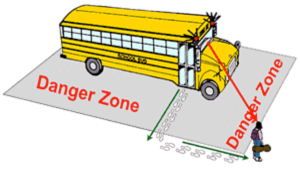
School bus travel is very safe in Ontario. Injuries and fatalities, which are very rare, happen more often outside the school bus as students are boarding and leaving the bus or crossing the street.
It’s important for motorists, parents, caregivers and students to know how to keep children safe when they are on and around school buses.
Drivers: know the rules

When driving on a road WITHOUT a median:
- drivers travelling in both directions must stop for a stopped school bus with its upper red lights flashing and/or stop arm activated
- when you approach the bus from the front, stop at a safe distance to let children get on or off the bus and cross the road
- don't move forward until the red lights have stopped flashing and stop arm is no longer activated or the bus begins to move
When driving on a road WITH a median:
- traffic coming from the opposite direction is not required to stop.
Fines
Drivers can be charged if they pass a stopped school bus with its upper red lights flashing and/or stop arm activated:
- First offence: $400 to $2,000 and six demerit points..
- Each following offence: $1,000 to $4,000, six demerit points and possible jail time (up to six months)
Vehicle owners can be charged if their vehicle illegally passes a stopped school bus, even if they weren't driving.
School Bus Stop Arm Cameras
As of September 1, 2020, the ministry is making it easier for municipalities to set up school bus stop arm cameras in their region. This change to streamline the prosecution of camera offences will help to ensure that violators are penalized.
Where a vehicle illegally passes a school bus and is caught by camera technology the vehicle owner may be charged – fines but not demerit points may apply in these cases.
Students: Stay safe

School bus travel is very safe in Ontario. Injuries and fatalities, which are very rare, happen more often outside the school bus as students are boarding and leaving the bus or crossing the street.
Parents, help keep your children safe by talking about bus safety with them.
When you board or leave a bus
- Be at the bus stop before the bus comes.
- Wait in a safe place well back from the edge of the road - don't play in ditches or on snow banks.
- Stay out of the DANGER ZONE. If you can touch the bus, you're too close. U se 10 giants steps to take you out of the DANGER ZONE, and make sure you and the bus driver can see each other.
- Always cross the road in front of the bus, never behind.
- Look all ways and wait for the driver to signal before you cross in front of a bus.
- Walk at least 10 big steps from the front of the bus.
- Enter or exit the bus in single file. Never push or shove.
- Walk - never run - across the road.
- NEVER stop to pick up anything that you may have dropped in the DANGER ZONE. Ask an adult or the bus driver to help.
While on the bus
- Find a seat right away. Stay seated, facing forward at all times.
- Don't put things in the aisle.
- Never distract the bus driver. Always follow his or her instructions.
- Don't eat or drink.
- Don't yell, push people or throw things.
- Keep your arms and head inside the bus.
Reporting Drivers Who Don’t Stop
You can report a vehicle that doesn't stop properly for a school bus to police immediately by calling 911.
You can also go to the nearest police station and file a complaint. The police will ask you:
- The date and time of the incident.
- The vehicle's make, model, colour and licence number.
- Who was driving?
- Was the bus a "chrome yellow" school bus with the words "School Bus" at both the front and rear of the bus?
- Was it a small or a large school bus?
- Was the school bus stopped?
- Were the upper red lights of the school bus flashing and/or stop arm activated while it was stopped?
- Were there passengers boarding or leaving the school bus?
- Did the vehicle pass the school bus from behind or was it coming toward the bus in the opposite lane?
Other details can also help, such as witness accounts or photographs.
Frequently Asked Questions
Q1: Are school buses safe?
Yes. Ontario regulations require buses be driven by specially trained, licensed drivers with good driving records. All school buses must meet safety standards established by Transport Canada and the province. For example, in Ontario all school buses must have a front safety crossing arm.
Q2: Why are there no seatbelts on school buses?
MTO continuously monitors developments in the industry and works with our road safety and industry partners to assess additional safety features on school buses. Due to the unique design of school bus seating, Transport Canada does not require seat belts to be installed on school buses at this time, other than for the driver.
School buses are designed to protect passengers through compartmentalization. High-back seats with energy-absorbing seat backs and padding are closely spaced together to contain passengers in the seating position.
Transport Canada is responsible for setting safety standards for equipment, including seat belts, on new vehicles and would be responsible for making any possible changes in those standards.
Q3: Are electric school buses (ESBs) safe?
Yes. ESBs that are part of the Electric School Bus Pilot Program need to meet the same safety standard that applies to diesel school buses, known as the D250-16 safety standard.